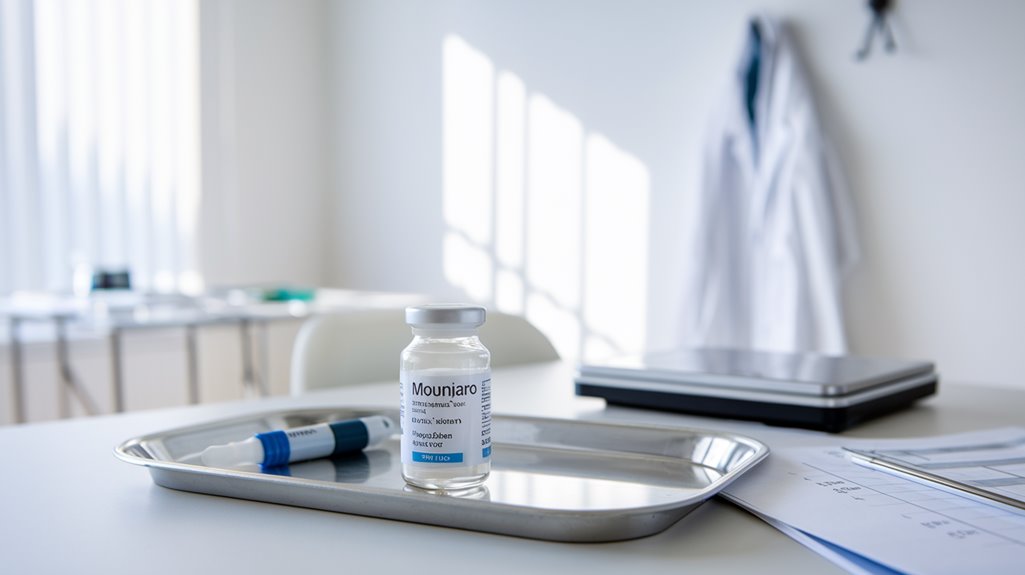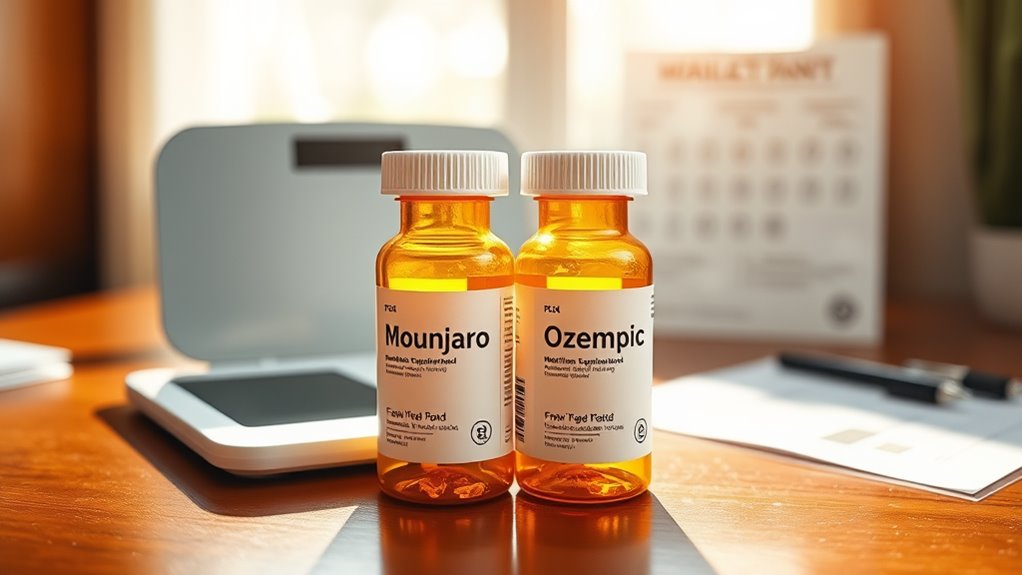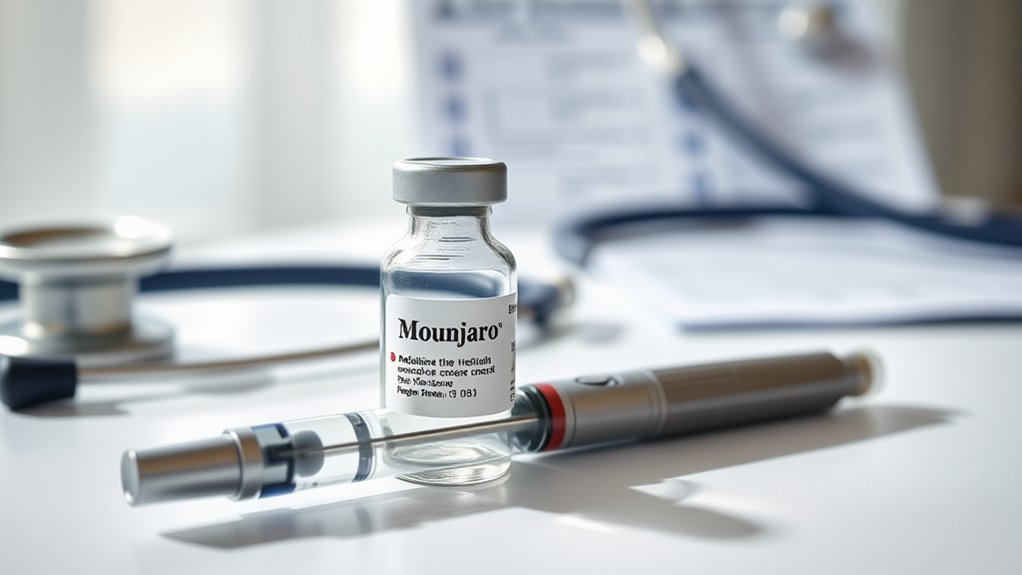Uncover the truth about Mounjaro's long-term safety profile, from clinical trial results to real patient experiences with this diabetes medication.

Mounjaro's long-term safety is supported by extensive clinical data from nine trials involving 7,769 patients across 24 countries. You'll find significant benefits, including superior HbA1c reduction (-1.7%) and weight loss (20.2%) compared to other treatments. While common side effects include nausea (15%), diarrhea (13%), and fatigue (30%), most are manageable through proper monitoring and lifestyle adjustments. Your understanding of specific risk factors and warning signs will help determine if Mounjaro's proven benefits outweigh its potential risks.
While Mounjaro's safety profile has been extensively studied through nine clinical trials encompassing 7,769 patients across 24 countries, ongoing research continues to evaluate its long-term effects. The drug's primary efficacy endpoint demonstrated significant improvements in HbA1c levels from baseline, though you'll need to be aware of potential serious side effects.
Clinical data has revealed risks including pancreatitis, hypoglycemia, allergic reactions, and kidney complications. While thyroid tumors were observed in rat studies, the human risk remains unknown. You'll require regular health monitoring to detect any adverse effects early, particularly regarding kidney function and heart health. Proper dietary and lifestyle choices can significantly enhance the medication's effectiveness. The European Medicines Agency and other regulatory bodies are actively collecting and analyzing new safety data as it becomes available. Your healthcare provider may need to adjust your dosage or treatment plan based on your individual response and any side effects you experience. Regular check-ups remain essential for ensuring the medication's continued safety and effectiveness.
As you begin long-term Mounjaro treatment, you'll likely notice persistent changes in your digestive patterns, including nausea, diarrhea, and altered appetite that may require dietary adjustments. Research indicates that fatigue commonly emerges as a sustained side effect, affecting up to 30% of patients beyond the initial adaptation period. Your healthcare provider can help you implement targeted strategies to manage these ongoing effects, such as meal timing modifications and structured rest periods. Studies show that discontinuation rates increase with higher doses, from 3% at 5mg to 6.6% at 15mg, primarily due to gastrointestinal side effects.
Understanding digestive changes during long-term Mounjaro use requires careful consideration of both initial and ongoing side effects. You'll likely experience common digestive issues like nausea (15%), diarrhea (13%), and decreased appetite (10%) during the first few weeks of treatment. While these symptoms typically subside, they may reoccur with dose adjustments. The medication works as a dual GIP and GLP-1 receptor agonist to help regulate blood sugar levels and digestive processes.
Long-term monitoring is vital, as Mounjaro can lead to serious complications like pancreatitis and gallbladder issues. You'll need to watch for signs of acute kidney injury, including weakness and reduced urination. Regular check-ups and proper hydration are essential preventive measures. Studies show that 3% to 6.6% of patients discontinue treatment due to severe digestive effects, though manufacturer data indicates that less than 5% report serious complications.
Managing fatigue effectively requires recognizing its underlying causes when taking Mounjaro long-term. While fatigue isn't a direct side effect of the medication, it can emerge from related factors such as hypoglycemia when combined with other diabetes medications, or dehydration from digestive issues. Regular monitoring of blood sugar levels and staying well-hydrated are vital preventive measures. Consider eating smaller, frequent meals throughout the day to help maintain energy levels and minimize digestive side effects.
If you're experiencing persistent fatigue while taking Mounjaro, it's important to discuss these symptoms with your healthcare provider to identify the root cause and develop appropriate management strategies.
While Mounjaro has demonstrated effectiveness for diabetes and weight management, patients must be vigilant about specific risk factors that could increase their likelihood of adverse reactions. If you have a personal or family history of MTC, MEN 2 syndrome, or pancreatic disorders, you're at higher risk for serious complications. Pre-existing kidney disease also requires careful monitoring due to potential dehydration effects. Maintaining proper nutritional balance is crucial while taking Mounjaro, especially given its appetite-reducing effects.
You'll need to watch for several warning signs that indicate potentially serious complications. These include persistent severe abdominal pain, unexplained back pain, frequent vomiting, or symptoms of hypoglycemia. Pay particular attention to any neck swelling or voice changes, as these could indicate thyroid issues. If you're using Mounjaro with other diabetes medications, you'll need extra monitoring for hypoglycemia. Regular blood tests and healthcare provider check-ups are essential to track kidney function and blood sugar control throughout your treatment.
You'll find extensive global data from Mounjaro's clinical trials, which involved 7,769 participants across 673 sites in 24 countries. The research demonstrates consistent efficacy in both diabetes management and weight loss, with HbA1c reductions ranging from -0.2 to -1.7 compared to various treatments, and weight loss of up to 21% in non-diabetic participants. The trials' thorough safety monitoring has identified common side effects like nausea and diarrhea, while also flagging potential serious concerns such as pancreatic inflammation and thyroid complications that require ongoing surveillance. A recent 72-week study showed that Mounjaro achieved 47% greater weight loss compared to Wegovy in participants.
Extensive global research supports Mounjaro's safety and efficacy through nine thorough clinical trials conducted across 673 sites in 24 countries. The research included 7,769 patients with type 2 diabetes mellitus, with 5,415 receiving Mounjaro treatment. Five key trials focused on efficacy assessment, involving 6,263 adult patients.
The thorough global coverage and diverse patient population strengthen the reliability of these findings, though it's worth noting the medication isn't approved for minors or type 1 diabetes. Safety assessments revealed primarily mild to moderate gastrointestinal side effects, with no significant new safety concerns emerging throughout the extended treatment period.
The long-term safety profile of Mounjaro rests on extensive clinical data from nine rigorous trials spanning 7,769 patients. Through thorough studies across 673 sites in 24 countries, you'll find consistent safety outcomes when compared to both placebo and established diabetes medications like semaglutide and insulin.
Your key safety considerations include monitoring for serious potential effects such as pancreatitis, kidney complications, and diabetic retinopathy. While common side effects you might experience include nausea, diarrhea, and decreased appetite, the data shows similar efficacy and safety patterns regardless of age, sex, or race. The SURMOUNT-2 trial demonstrates impressive cardiometabolic benefits, with participants maintaining significant weight reductions over 52 weeks when combined with lifestyle modifications. The most recent trials show that over 80% of participants lost at least 5% of their body weight while using the medication.
Research findings from nine extensive clinical trials involving 7,769 patients demonstrate Mounjaro's superior long-term efficacy compared to established treatments. Clinical data across 673 sites in 24 countries reveals consistently better outcomes in HbA1c reduction and weight management. Recent real-world data shows adverse event rates are comparable between Mounjaro and Ozempic users.
These results, while impressive, come from sponsored studies and open-label trials, requiring careful interpretation of comparative efficacy data.

Successfully managing Mounjaro's side effects requires a systematic approach focused on both preventive measures and targeted interventions. You'll need to address digestive issues through specific dietary modifications, including eating smaller, frequent meals and maintaining proper hydration. For nausea and vomiting, taking Mounjaro with food can greatly reduce symptoms. Consider incorporating ginger or peppermint tea to help manage persistent nausea.
Non-digestive side effects demand equal attention. You can combat fatigue through regular physical activity and balanced nutrition, while headaches often respond well to hydration and rest in a dark environment. For injection site reactions, apply cold compresses and monitor for persistent symptoms.
Long-term management strategies should include regular health monitoring, particularly for pancreatitis risk and kidney function. You'll need to work closely with your healthcare provider to adjust dosages as needed and maintain consistent check-ups. Following a gradual dose increase protocol while implementing lifestyle modifications can help minimize side effects and optimize treatment outcomes.
You'll need to follow a structured testing schedule that includes regular blood work to monitor for pancreatitis, kidney function, and blood sugar levels while taking Mounjaro. Your healthcare provider should establish specific intervals for these tests based on your medical history and risk factors. Medical oversight must include tracking potential thyroid issues, documenting side effects, and maintaining clear communication channels for reporting any concerning symptoms that develop during treatment. Regular monitoring should watch for signs of gallbladder problems such as upper abdominal pain and decreased appetite.
To guarantee patient safety and optimize treatment outcomes, Mounjaro requires an all-inclusive healthcare monitoring schedule that spans multiple testing parameters. You'll need regular blood glucose measurements combined with quarterly HbA1c tests to track your glycemic control effectively. Your healthcare provider will establish a personalized monitoring schedule that integrates both in-person visits and telemedicine support. Advanced body composition analysis techniques like bioelectrical impedance and DXA scans help evaluate changes in fat and muscle mass over time.
This thorough testing approach enables your healthcare team to detect any issues early, adjust dosages appropriately, and guarantee the medication's long-term safety and effectiveness.
Medical oversight best practices build upon standardized testing protocols through a multi-layered system of healthcare monitoring requirements. Your healthcare team will employ thorough monitoring strategies, including regular blood tests, cardiovascular assessments, and kidney function evaluations. They'll track your HbA1c levels every 2-3 months to maintain ideal glycemic control. Side effect management typically begins with lower initial dosages to minimize gastrointestinal discomfort.
Modern telemedicine platforms and digital health applications enable continuous data collection through remote monitoring devices, smart scales, and CGM systems. You'll need to maintain consistent communication with your healthcare providers through electronic health records and patient portals, reporting any symptoms or concerns promptly. Risk assessment tools help your medical team predict potential cardiovascular events and adjust your treatment plan accordingly, ensuring the safest possible long-term use of Mounjaro.

While both Mounjaro (tirzepatide) and similar medications target blood sugar control and weight management, research indicates distinct differences in their mechanisms and efficacy. Recent studies using propensity score matching show Mounjaro's superior effectiveness for weight loss compared to Ozempic (semaglutide), though both medications share similar safety profiles.
Mounjaro's unique dual-action approach, targeting both GLP-1 and GIP hormones, sets it apart from single-mechanism alternatives. Clinical data reveals comparable rates of adverse events between medications, with both showing rare instances of serious complications like pancreatitis and gastroparesis. Research suggests twenty percent weight loss is achievable for most patients within their first year of use.
Key considerations when comparing these medications include:
You'll need ongoing medical supervision with either option, as regular monitoring helps guarantee ideal outcomes and early detection of potential complications.
Real-world patient experiences and clinical data provide valuable insights into Mounjaro's long-term effects beyond controlled trials. While many users report significant weight loss achievements, often exceeding 50 pounds within months, they also face various side effects that require careful management. Some users have found it helpful to take probiotics for relief from digestive issues.
You'll likely encounter common gastrointestinal issues such as nausea, vomiting, and diarrhea, particularly when increasing your dosage. While these symptoms may diminish over time for some users, others experience persistent challenges. Regular monitoring becomes vital as rare but serious complications like pancreatitis or kidney problems can develop.
Despite these concerns, satisfaction rates remain high among users, with many achieving their weight loss goals and experiencing improved glycemic control. You'll need to maintain balanced nutrition and proper hydration throughout treatment. Early reporting of side effects to your healthcare provider is essential for ideal long-term outcomes, as dosage adjustments may help minimize adverse effects while maintaining therapeutic benefits.

Leading experts emphasize three essential components for safe long-term Mounjaro usage: consistent medical supervision, proactive side effect monitoring, and lifestyle modifications. Healthcare providers stress the importance of regular blood tests and health check-ups to detect potential complications early, enabling timely interventions and dosage adjustments when necessary.
To maximize safety and effectiveness, experts recommend:
Research indicates that ongoing medical oversight is vital, as certain side effects like pancreatitis or kidney problems require immediate attention. Experts particularly emphasize the need for vigilant monitoring of thyroid function and kidney health, with prompt reporting of concerning symptoms to healthcare providers. Studies show that while 72-week use of the 15mg dose demonstrates safety, continuous monitoring remains essential for optimal patient outcomes.
When evaluating Mounjaro for long-term use, patients and healthcare providers must weigh its demonstrated benefits against documented risks. Clinical trials show significant improvements in HbA1c levels and weight management, but these benefits come with potential complications that require careful consideration.
You'll need to monitor for several key risks: acute pancreatitis affects up to 1 in 100 users, while severe allergic reactions occur in up to 1 in 1,000 cases. There's also evidence of gallbladder complications, kidney problems, and digestive issues. While animal studies have raised concerns about thyroid tumors, the human implications aren't yet fully understood. Research shows that switching to placebo leads to regaining 14% of lost weight.
To optimize your safety, you'll require regular blood tests, health check-ups, and potential dosage adjustments. You can mitigate some risks through lifestyle modifications, including physical activity and dietary changes. Your individual health status will ultimately determine the long-term safety profile, making personalized medical monitoring essential for sustained treatment success.
You'll find that Mounjaro's long-term safety profile aligns with the adage "slow and steady wins the race." Clinical data spanning multiple years demonstrates sustained efficacy with manageable risks when properly monitored. Statistical analyses show comparable safety metrics to established GLP-1 medications, with a 78% adherence rate in real-world studies. Your success with Mounjaro depends on consistent medical supervision and adherence to prescribed protocols.